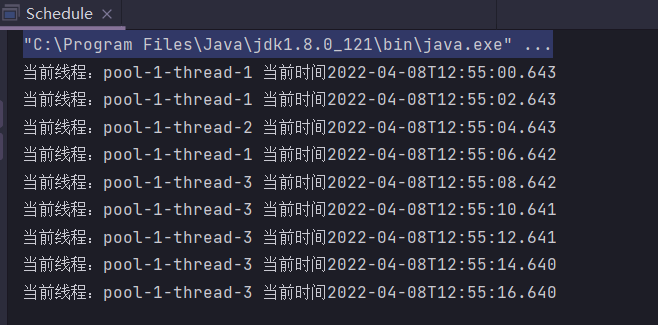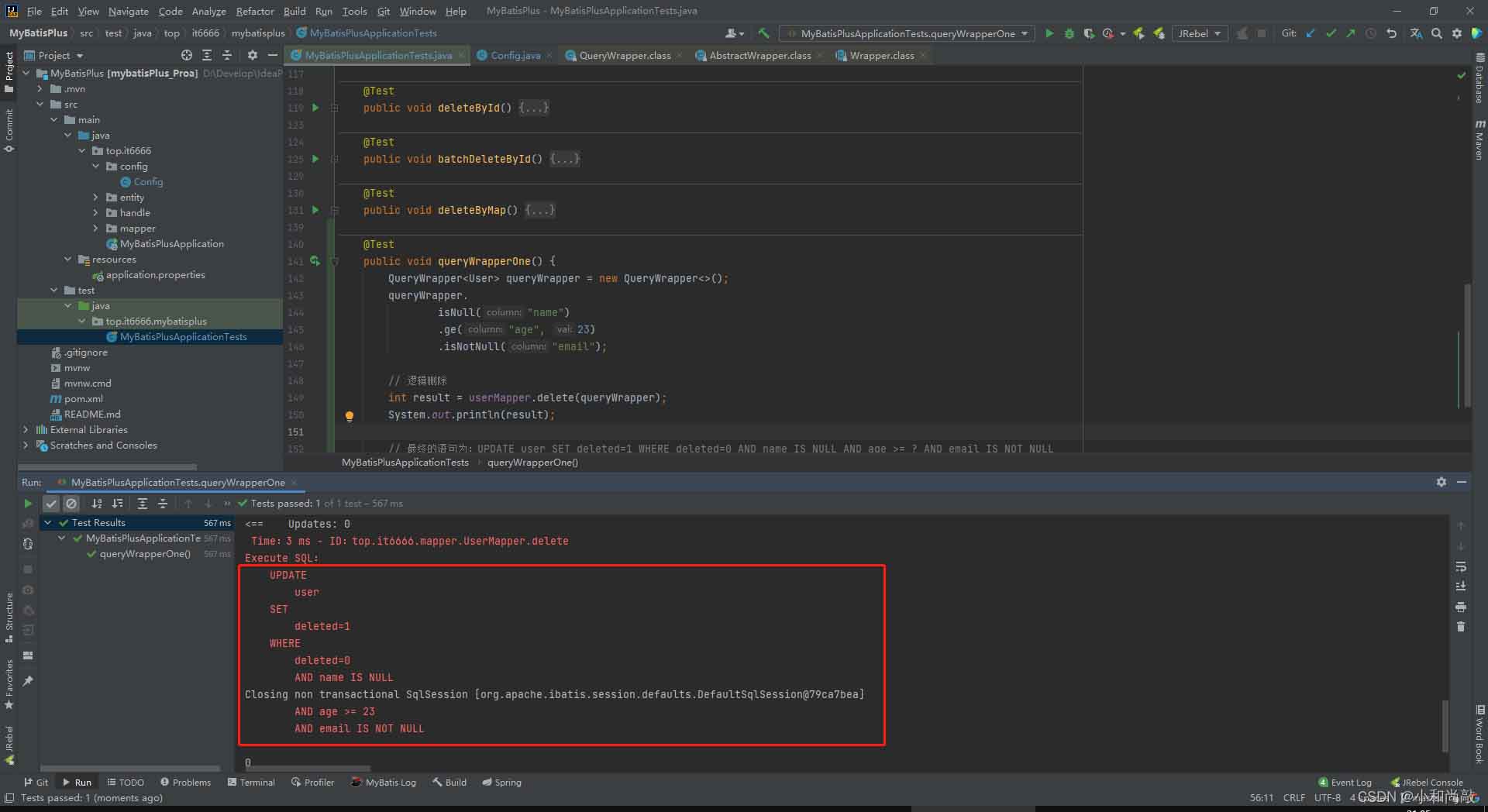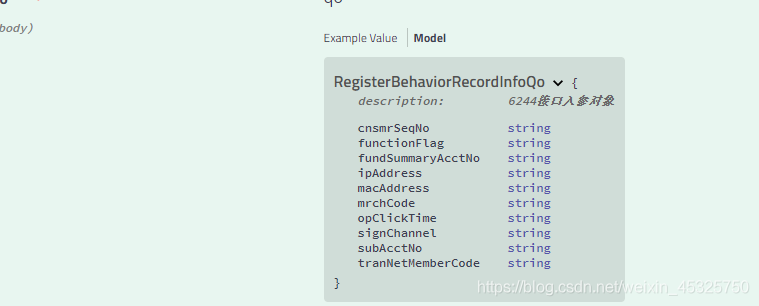基于SSM+Shiro+Bootstrap实现用户权限管理系统 目录 引言 需求 效果图 功能细节 数据表准备 pom文件 项目结构 核心源码 Shiro退出登录 启动项目命令 引言 本篇博文基于SSM+Shiro实现用户权限管理系统,每位用户只可访问指定的页面,具体需求如下 需求 用
目录
- 引言
- 需求
- 效果图
- 功能细节
- 数据表准备
- pom文件
- 项目结构
- 核心源码
- Shiro退出登录
- 启动项目命令
引言
本篇博文基于SSM+Shiro实现用户权限管理系统,每位用户只可访问指定的页面,具体需求如下
需求
用户账号的增删改查功能
权限包括: 系统模块操作权限(system),财务模块操作权限(finance),考勤模块操作权限(checkon),
每个用户都可能拥有0或多个权限,在新增和编辑用户的时候,可以多选权限。
系统模块:包括用户账号管理功能。
财务模块:为了开发简化,只要做出静态的页面即可,不要真的有财务模块。
考勤模块:同财务模块。
效果图
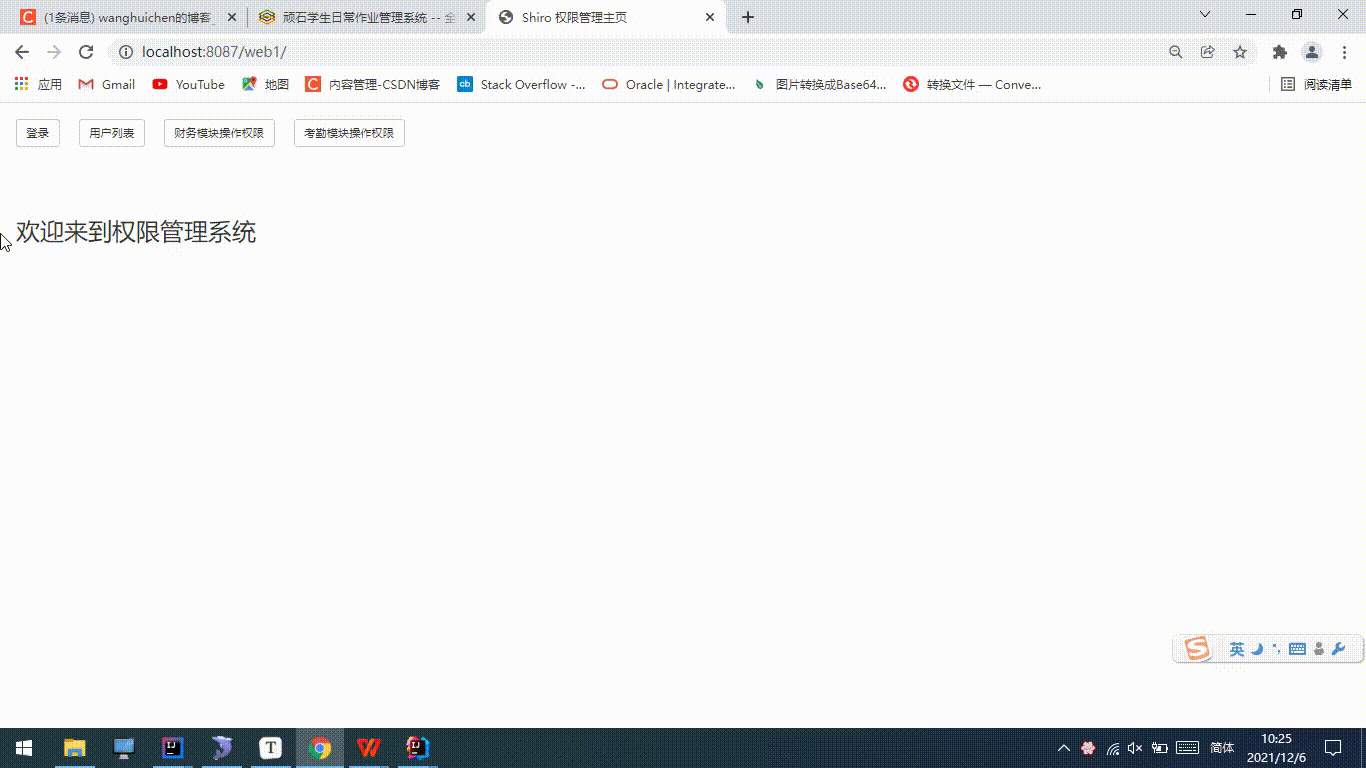
功能细节
- 技术栈: Maven+SSM+Shiro + Bootstarp
- 操作者必须登录,且拥有system权限才可以访问system/* 下的所有页面和功能
- 操作者必须登录,且拥有 finance 权限才可以访问 finance/* 下的所有页面和功能
- 操作者必须登录,且拥有 checkon 权限才可以访问 checkon/* 下的所有页面和功能
- 用户的新增、编辑、删除、列表功能,都属于 system/* 下面的页面和功能。
- 操作者如果未登录,会被踢到登录页面
- 操作者如果访问需要权限的页面,但没有权限,会被踢到 noauthor 页面
- 用户新增和编辑页面,必须验证登录密码和二次验证密码相同
- 用户名必须是唯一的
- 用户新增的时候必须输入用户名
- 用户编辑的时候,用户名为只读的
- 用户编辑的时候,可以不输入密码
- 用户编辑页面打开的时候,不要回显密码
- 用户新增的时候必须输入登录密码
- 用户编辑回显的时候必须回显昵称和拥有权限
分页采用PageHelper插件
数据表准备
用户表:t_shiro_user
CREATE TABLE `t_shiro_user` (
`noid` int(11) NOT NULL AUTO_INCREMENT,
`username` varchar(32) NOT NULL,
`userpwd` varchar(32) NOT NULL,
`nickname` varchar(32) DEFAULT NULL,
PRIMARY KEY (`noid`),
UNIQUE KEY `uniq_username` (`username`)
) ENGINE=InnoDB DEFAULT CHARSET=utf8mb4
权限表:t_shiro_permission
CREATE TABLE `t_shiro_permission` (
`noid` int(11) NOT NULL AUTO_INCREMENT,
`permission_code` varchar(32) NOT NULL COMMENT '权限代号',
`permission_describe` varchar(32) NOT NULL COMMENT '权限描述',
PRIMARY KEY (`noid`)
) ENGINE=InnoDB DEFAULT CHARSET=utf8mb4
权限代号是开发的时候需要用的字符串,一般都是英文字符串,比如“system”。
权限描述是给最终软件使用方(操作者)看的,比如 “系统模块操作权限”
权限数据是固定的,这些数据是设计时的,即在开发前就确定的东西,不会在项目运行阶段再变化;如果需要变化就需要重新开发相关的代码。
权限表的数据如下:
INSERT INTO `t_shiro_permission` (`permission_code`, `permission_describe`) VALUES ('system', '系统模块操作权限');
INSERT INTO `t_shiro_permission` (`permission_code`, `permission_describe`) VALUES ('finance', '财务模块操作权限');
INSERT INTO `t_shiro_permission` (`permission_code`, `permission_describe`) VALUES ('checkon', '考勤模块操作权限');
pom文件
<dependencies>
<dependency>
<groupId>junit</groupId>
<artifactId>junit</artifactId>
<version>4.13.2</version>
<scope>test</scope>
</dependency>
<dependency>
<groupId>javax.servlet</groupId>
<artifactId>servlet-api</artifactId>
<version>2.5</version>
<scope>provided</scope>
</dependency>
<dependency>
<groupId>javax.servlet</groupId>
<artifactId>javax.servlet-api</artifactId>
<version>3.1.0</version>
<scope>provided</scope>
</dependency>
<dependency>
<groupId>javax.servlet</groupId>
<artifactId>jstl</artifactId>
<version>1.2</version>
</dependency>
<dependency>
<groupId>org.springframework</groupId>
<artifactId>spring-webmvc</artifactId>
<version>5.3.13</version>
</dependency>
<!-- mybatis 相关的依赖 -->
<dependency>
<groupId>org.springframework</groupId>
<artifactId>spring-jdbc</artifactId>
<version>5.3.13</version>
</dependency>
<dependency>
<groupId>mysql</groupId>
<artifactId>mysql-connector-java</artifactId>
<version>5.1.49</version>
</dependency>
<dependency>
<groupId>com.alibaba</groupId>
<artifactId>druid</artifactId>
<version>1.2.8</version>
</dependency>
<dependency>
<groupId>org.mybatis</groupId>
<artifactId>mybatis</artifactId>
<version>3.5.7</version>
</dependency>
<dependency>
<groupId>org.mybatis</groupId>
<artifactId>mybatis-spring</artifactId>
<version>2.0.6</version>
</dependency>
<!-- shiro依赖-->
<dependency>
<groupId>org.apache.shiro</groupId>
<artifactId>shiro-core</artifactId>
<version>1.8.0</version>
</dependency>
<dependency>
<groupId>org.apache.shiro</groupId>
<artifactId>shiro-spring</artifactId>
<version>1.8.0</version>
</dependency>
<!-- 分页插件-->
<dependency>
<groupId>com.github.pagehelper</groupId>
<artifactId>pagehelper</artifactId>
<version>5.1.11</version>
</dependency>
</dependencies>
<properties>
<maven.compiler.source>8</maven.compiler.source>
<maven.compiler.target>8</maven.compiler.target>
<project.build.sourceEncoding>UTF-8</project.build.sourceEncoding>
<project.reporting.outputEncoding>UTF-8</project.reporting.outputEncoding>
<maven.compiler.encoding>UTF-8</maven.compiler.encoding>
</properties>
<build>
<plugins>
<plugin>
<groupId>org.apache.maven.plugins</groupId>
<artifactId>maven-compiler-plugin</artifactId>
<version>3.1</version>
<configuration>
<source>1.8</source>
<target>1.8</target>
</configuration>
</plugin>
<plugin>
<groupId>org.apache.tomcat.maven</groupId>
<artifactId>tomcat7-maven-plugin</artifactId>
<version>2.2</version>
<configuration>
<port>8087</port>
<path>/ssm_shiro</path>
<uriEncoding>UTF-8</uriEncoding>
</configuration>
</plugin>
</plugins>
</build>
项目结构
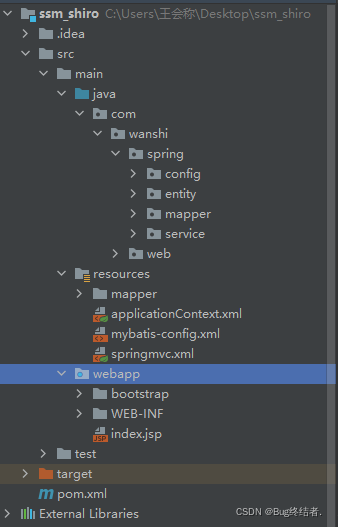
核心源码
MyRealm自定义权限类,该类实现了用户认证与授权
@Component
public class MyRealm extends AuthorizingRealm {
@Autowired
private ShiroUserMapper shiroUserMapper;
@Autowired
private UserPermissionMapper userPermissionMapper;
/**
* 自定义授权方法
* 思路:根据PrincipalCollection对象获取用户名,根据用户名查询对象,
* 查询该用户在数据表中所对应的权限,并转换为set集合,存入SimpleAuthorizationInfo对象并返回
* @param principalCollection
* @return
*/
@Override
protected AuthorizationInfo doGetAuthorizationInfo(PrincipalCollection principalCollection) {
//获取用户名
String username = (String) principalCollection.getPrimaryPrincipal();
//根据用户名获取用户对象
ShiroUser shiroUser = new ShiroUser();
shiroUser.setUsername(username);
ShiroUser user = shiroUserMapper.get(shiroUser);
//用户非空判断
if (user != null) {
//获取用户所对应的权限
UserPermission userPermission = new UserPermission();
userPermission.setUser_id(user.getNoid());
List<String> list = userPermissionMapper.list(userPermission);
//List集合转为Set集合放入授权权限实例对象中
Set<String> perms = new HashSet<>();
for (String s : list) {
perms.add(s);
}
SimpleAuthorizationInfo authorizationInfo=new SimpleAuthorizationInfo();
authorizationInfo.addStringPermissions(perms);
return authorizationInfo;
}
return null;
}
/**
* 自定义认证方法,根据AuthenticationToken对象获取用户名,
* 查询用户名对应的都系,并进行验证是否正确,最后返回AuthenticationInfo对象
* @param authenticationToken
* @return
* @throws AuthenticationException
*/
@Override
protected AuthenticationInfo doGetAuthenticationInfo(AuthenticationToken authenticationToken) throws AuthenticationException {
String username = (String) authenticationToken.getPrincipal();
ShiroUser shiroUser = new ShiroUser();
shiroUser.setUsername(username);
ShiroUser user = shiroUserMapper.get(shiroUser);
if (user != null) {
// 这一步就执行了对密码的验证
AuthenticationInfo authcInfo=new SimpleAuthenticationInfo(user.getUsername(),user.getUserpwd()
, getName());
return authcInfo;
} else {
return null;
}
}
}
核心配置文件applicationContent.xml
<!-- 安全管理,将 myRealm嵌入 -->
<bean id="securityManager" class="org.apache.shiro.web.mgt.DefaultWebSecurityManager">
<property name="realm" ref="myRealm"/>
</bean>
<!-- Shiro过滤器 -->
<bean id="shiroFilter" class="org.apache.shiro.spring.web.ShiroFilterFactoryBean">
<!-- Shiro的核心安全接口,这个属性是必须的 -->
<property name="securityManager" ref="securityManager"/>
<!-- 身份认证失败,则跳转到登录页面的配置 -->
<property name="loginUrl" value="/user/login"/>
<!-- 权限认证失败,则跳转到指定页面 -->
<property name="unauthorizedUrl" value="/system/noauthor"/>
<!-- Shiro连接约束配置,即过滤链的定义 -->
<property name="filterChainDefinitions">
<value>
<!-- 游客身份,表示登录就可以访问-->
/loginPost=anon
<!-- user赋值的不登录,无无法访问,直接就是认证失败。-->
/system/*=user
<!-- 访问以finance打头的接口必须拥有finance权限-->
/finance/*=perms[finance]
<!-- 访问以checkon打头的接口必须拥有checkon权限-->
/checkon/*=perms[checkon]
<!-- 退出登录,无需写controller,只写配置及写对应的跳转即可实现退出登录-->
/logout.action=logout
</value>
</property>
</bean>
<!-- 保证实现了Shiro内部lifecycle函数的bean执行 -->
<bean id="lifecycleBeanPostProcessor" class="org.apache.shiro.spring.LifecycleBeanPostProcessor"/>
<!-- 开启Shiro注解 -->
<bean class="org.springframework.aop.framework.autoproxy.DefaultAdvisorAutoProxyCreator" depends-on="lifecycleBeanPostProcessor"/>
<bean class="org.apache.shiro.spring.security.interceptor.AuthorizationAttributeSourceAdvisor">
<property name="securityManager" ref="securityManager"/>
</bean>
Shiro退出登录
applicationContent.xml
<!-- 退出登录,无需写controller,只写配置及写对应的跳转即可实现退出登录-->
/logout.action=logout
通用jsp,inc.jsp
<%--点击该链接,applicationContent.xml中配置的退出登录进行拦截, shiro内部实现退出登录并清空缓存 --%>
<a href="${APP_PATH}/logout.action" rel="external nofollow" ${user == null ? 'style="display: none"':'style="display: inline-block"'} class="btn btn-danger">退出登录</a>
启动项目命令
mvn clean tomcat7:run
IDEA配置如图

建议采用DeBug方式启动
到此这篇关于基于SSM+Shiro+Bootstrap实现用户权限管理系统的文章就介绍到这了,更多相关SSM+Shiro+Bootstrap用户权限管理系统内容请搜索我们以前的文章或继续浏览下面的相关文章希望大家以后多多支持我们!
本文标题为:基于SSM+Shiro+Bootstrap实现用户权限管理系统


基础教程推荐
- Java编写实现窗体程序显示日历 2023-01-02
- JavaWeb 实现验证码功能(demo) 2024-04-14
- 是否适合从javabean类更新数据库? 2023-11-04
- 使用Java和WebSocket实现网页聊天室实例代码 2024-02-25
- JSP 动态树的实现 2023-12-17
- 深入理解约瑟夫环的数学优化方法 2024-03-07
- springboot下使用shiro自定义filter的个人经验分享 2024-02-27
- 运用El表达式截取字符串/获取list的长度实例 2023-08-01
- Java中EnvironmentAware 接口的作用 2023-01-23
- Java+mysql实现学籍管理系统 2023-03-16









